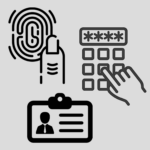Patient Identification Options
At the arrivals and checkout stations, patients need to be accurately identified. There are three supported methods. Each have their pros and cons.
Finger scanner
Pros: The finger scanner is fast, easy and fun. Patients love it. Big wow-factor on day one.
Con: They don’t work for everyone. Depends on you patient demographic, but typically 1-5% failure rate so you do need a backup with on of the other ID techniques. Failure most common with fingers of elderly patients especially in cold and dry weather.
Equipment required: Finger scanner and license. Require 1 for Arrivals, 1 for Checkout (if used), 1 for fingerprint capture at Reporting/Frontdesk. i.e. 2 or 3 required.
Cost: AUD250 per scanner.
Summary: We highly recommend the use of finger scanners. They are cool and effective.
PIN
You can record a PIN for a patient. Typically you use their full date of birth, unless that has been used by someone else.
Pros: 100% reliable
Cons: Time-consuming for patients to enter, patient may need to use glasses to see, some elderly patients forget their DOB (rare, but does happen!), some elderly patients get mixed up between 2-digit and 4-digit year code.
Equipment required: On-screen key-pad if touch screen, otherwise, numeric keypad. For the latter, you’ll need one at Arrivals and one at Checkout.
Cost: If already have touch screen, free, numeric keypad: AUD10 on Ebay.
Summary: PIN is an excellent backup method, but is slow and lacks pizazz. Not so great for high-volume offices.
Barcode
You can generate a barcode on a card and give it to the patient. They then produce the card and scan it.
Pros: 100% reliable. Fast. Easy… **if** the patient has their card
Cons: Patients forget them, patients lose them.
Equipment required: Barcode on a card or key-tag for each patient, barcode reader at both Arrivals and Checkout.
Cards: You can generate the cards directly out of Spinalogic with your printer, cut them out and laminate in a credit-card lamination pouch. It’s labour-intensive but they include your practice details and patient name – handy for cards left behind.
Alternatively, you can get them printed on a credit-card style of stock or on a key-tag by a third party. Patient name is not included on card, key-tags are typically not durable.
Cost, Cards: Self-created: cents per card. Third-party: AUD1 per card
Cost, Scanners: AUD150-500 each. Recommend Honeywell or Metrologic Orbit scanner. New is not required.
Summary: Management of lost/forgotten cards is very annoying and time-consuming. But… patients who can’t use their fingerprints are typically the same people who don’t for get their cards!
Overall Best Guidance
Use all 3. Initially, use fingerscanners and PIN. Then introduce cards later for the patients using PIN if you want to make their life a bit easier.
You can always depend on the PIN.
Tags
Accounts Admin Admin training appear appointment Appointments Calling Clinical Data Import DC Training Dictionaries Dictionary Documents Document Templates email Experts Finger Scanners firewall general settings GoLive HICAPS Hours Ignition Training Image Analysis Installation MAP Medicare Overdue patient Patient Flow Payments PDF Save Time Training Slow SMS Statements Stocktake stripe sync Tech CA Training transaction Troubleshooting Video Zero-Touch Zurili



